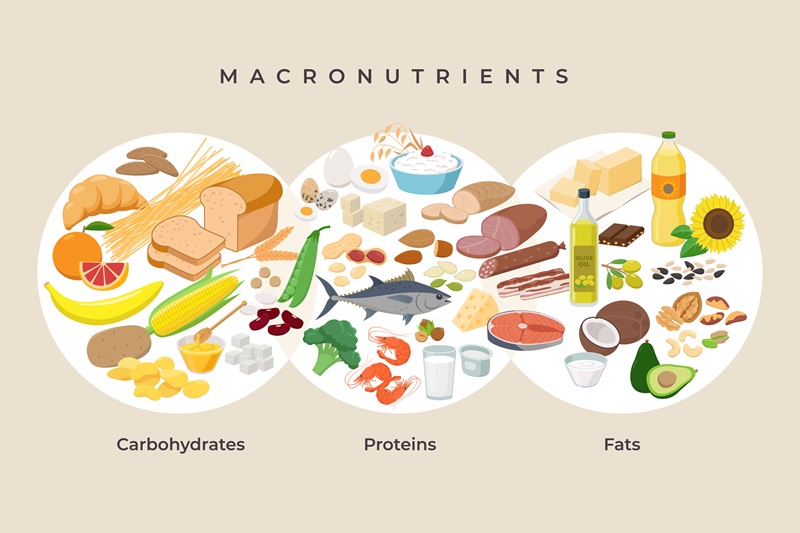Embarking on a weight loss journey can often feel like navigating through a maze of dietary advice, with each turn presenting a new theory on what works best for shedding pounds. Among the most hotly debated topics in nutrition is the best macros for weight loss: Should you go low fat, high protein or low carb?
This article aims to demystify the complex world of macronutrients—carbohydrates, fats and proteins—and their impact on weight loss. Join us as we delve into the latest research and the science behind each macronutrient’s role.
What Are Macros, Exactly?

Macros is a shortened name for macronutrients. Carbohydrates, proteins and fats are the primary macronutrients. Technically, alcohol is also considered a macronutrient, but most healthy diets do not include alcohol intake.
As the term macro suggests, your body needs large quantities of these nutrients to carry out daily functions. (Micronutrients, on the other hand, are vitamins and minerals that your body needs in much smaller amounts).
Each macronutrient uniquely impacts your body. For example:
- Carbohydrates are your primary source of energy. They’re also a significant source of fiber which contributes to heart, metabolic and digestive health.
- Proteins help with tissue repair and growth.
- Fats help with appetite regulation, hormone production and the absorption of vitamins A, D, E and K.
Most foods contain a mix of these nutrients, but many have a dominant macronutrient. For example:
- Poultry, fish, meat, soy, eggs and cheese are primarily protein but contain some fat.
- Cereal, rice, grains, bread, pasta, fruits and vegetables are primarily carbohydrates but contain some protein.
- Oils, butter, cream, avocado, nuts and seeds are primarily fats but may contain some protein and carbohydrates.
Each macronutrient also contributes a specific number of calories to your diet. Therefore, balancing your macros can help you manage your overall calorie intake.
- Carbohydrates and protein each provide four calories per gram.
- Fat provides nine calories per gram.
Do Macros Really Matter for Weight Loss?

It’s well known that the magic equation for losing weight is to eat fewer calories than you burn. As long as you maintain this calorie deficit, does adjusting your macro ratios matter?
The short answer is yes. But not in the way that you might think.
When it comes to tweaking macronutrients, people often think this means cutting out certain things like fat or carbs to amp up weight loss. But there isn’t much solid evidence backing up these approaches. In some cases, these practices can even be harmful.
On the flip side, maintaining a healthy balance of macronutrients is a solid strategy to fine tune your diet so you achieve better, long-lasting results for your health.
Take the low-fat diet movement as an example. Health experts recommended low-fat diets for many years to combat weight gain. The reasoning was that fats contribute the most calories per gram, so limiting them would be the easiest way to control calorie intake.
Yet, despite folks cutting back on their fat intake, obesity levels continue to rise. The culprit? People replaced fat with sugar-laden refined carbohydrates, which are known to promote weight gain.
In response, low-carb dieting skyrocketed in popularity. However, concerns arose about the potential negative impact on heart health due to the high-fat content in these diets. Additionally, while low-carb diets may lead to faster initial weight loss, research indicates they offer no long-term advantage over any other diet.
These examples demonstrate that focusing on a single macronutrient, without considering the overall balance of one’s diet, has a limited impact on health and weight loss outcomes. Numerous studies have gone on to corroborate this.
One study published in the New England Journal of Medicine compared the impact of four reduced-calorie diets with varying proportions of fat, carbohydrate, and protein on weight loss outcomes over two years. The results showed no significant difference in weight loss between the diets, leading the researchers to conclude that “reduced-calorie diets result in clinically meaningful weight loss regardless of which macronutrients they emphasize.”
So why even bother discussing macros when it comes to weight loss? While tweaking macro ratios won’t directly impact your weight, maintaining a balanced mix of macronutrients can indirectly support your goals by enhancing diet quality and making dietary changes more sustainable and achievable.
The right balance of proteins, carbohydrates, and fats can deliver essential vitamins and minerals, support a healthy metabolism, improve appetite control, and boost energy levels, making sticking to your healthy eating goals easier.
The key takeaway: reduce your calories to see weight loss results, then balance macros to ensure diet quality and support long-term weight management.
The Best Macros for Weight Loss Results

Once you know your calorie target, how much of your total calories should come from protein, calories, and fat to support healthy weight loss?
The National Academy of Sciences recommends the following ranges for overall health:
- 10-35% of calories from protein
- 45-65% of calories from carbohydrates
- 20-35% of calories from fats
However, research suggests you can help your weight loss efforts by dialing in these numbers further.
A study published in the American Journal of Clinical Nutrition found that protein intakes above 25% of total calories influenced appetite-regulating hormones leading to better hunger control after meals. Researchers also observed that subjects consuming higher protein intakes maintained a higher metabolic rate and showed better muscle mass retention throughout the weight loss period.
Another New England Journal of Medicine study showed that people tended to stick with dietary changes in line with the Mediterranean diet that included higher amounts of healthy fats (>30% total calorie intake) versus a low-fat diet. Experts speculate diets that include ample vegetable oils and fats enhance the enjoyment and satisfaction derived from food.
Foods that are typically found in Mediterranean diets, including olive oil, fruits, vegetables, whole grains and fish, can also be included in the Nutrisystem weight loss plan and can be found in the Grocery Guide.
Finally, carbohydrates provide energy and fiber. Getting plenty of fiber is linked to long-term weight control and digestive and heart health. Certain fibers also influence your gut microbiome, and information continues to emerge about how a flourishing gut microbiome helps improve inflammation, blood sugar control, and metabolic health. For this reason, it’s important to maintain a minimum of 45% of calories from carbohydrates.
Since each person will respond differently to dietary changes, your specific targets will vary based on your health status, energy levels, hunger and weight goals. Make sure you discuss any diet changes with your healthcare provider.
4 Simple Steps to Balance Your Macros for Weight Loss

1. Focus on foods over numbers.
All of this macro talk can quickly feel like a complicated math equation. But we don’t eat numbers; we eat meals.
Familiarize yourself with the food sources of each macronutrient and think about how you can build balanced meals around them.
The plate method supported by the Centers For Disease Control and Prevention is a great visual tool for building balanced meals.
This method involves visualizing a nine-inch plate and drawing a line down the middle. Fill one half with non-starchy veggies. Split the remaining half evenly between fiber-rich carbohydrates and lean proteins. Finally, incorporate one to two tablespoons of healthy fat into the meal. Think: avocado, olive oil or nuts.
Nutrisystem Flex meal guidelines also teach you how to put together healthy and balanced meals that fit into your personalized calorie goal.
2. Look for simple tweaks to your existing diet.
Before you can improve your diet, you need to understand where you are today. Most people only need minor adjustments to achieve a more balanced macronutrient profile. Evaluate your current diet by looking at your plate at meals and see where you may be overbalanced and underbalanced.
3. Choose nutrient-dense options.
Remember, not all macronutrients are created equal. Donuts and oatmeal are both carbohydrates. However, while oatmeal is high in fiber to balance blood sugars and provide steady energy, donuts contain refined starches that will spike blood sugars and promote fat storage.
Choose foods across each macronutrient group that improve your diet quality. To achieve this:
- Choose carbohydrates with low added sugars and at least three grams of fiber per serving. These include whole grain bread, veggies, fruits, quinoa, barley and oats.
- Opt for lean protein sources low in saturated fat, like chicken, fish, turkey, soy, beans and legumes.
- Prioritize vegetable-based unsaturated fats like olive oil, canola oil, avocado, seeds and nuts over saturated fats like butter, shortening, and full-fat dairy and cheese.
4. Get help from structured programs.
Getting support from structured programs can help eliminate the guesswork of getting started with healthy diet changes.
Nutrisystem constructs its plans to deliver results through personalized calorie recommendations and balanced macronutrient profiles. Each plan aligns its nutritional targets with national health recommendations and the latest weight loss research. Nutrisystem plans are designed to meet, or exceed, the Healthy US-Style Dietary Pattern for Adults established by the government in the 2020-2025 Dietary Guidelines for Americans.
The standard Nutrisystem® program delivers approximately 45-55% of calories from carbohydrates, 25-30% of calories from protein, and less than 35% of calories from total fat. Our personalized plans, while still balanced, will be tailored to your nutritional needs.
Using Nutrisystem foods with your favorite grocery items will teach you how to put together meals with the right mix of macronutrients to see results – no number crunching required.
Bottom Line
You must reduce calorie intake to see weight loss results, but balancing your macronutrient intake can ensure you achieve a healthy weight in a sustainable way.
Avoid diets that encourage restricting any one specific nutrient group, as this is not an effective strategy for healthy weight loss and could be harmful to long term health.
Programs like Nutrisystem can help you reach your goals by teaching you how to build healthy meals with the right mix of nutrients to get results.
References
- Willett WC, Leibel RL. Dietary fat is not a major determinant of body fat. Am J Med. 2002;113 Suppl 9B:47S-59S.
- Chawla S, Tessarolo Silva F, Amaral Medeiros S, Mekary RA, Radenkovic D. The Effect of Low-Fat and Low-Carbohydrate Diets on Weight Loss and Lipid Levels: A Systematic Review and Meta-Analysis. Nutrients. 2020;12(12):3774. Published 2020 Dec 9.
- Sacks FM, Bray GA, Carey VJ, et al. Comparison of weight-loss diets with different compositions of fat, protein, and carbohydrates. N Engl J Med. 2009;360(9):859-873.
- Medicine I of. Dietary Reference Intakes for Energy, Carbohydrate, Fiber, Fat, Fatty Acids, Cholesterol, Protein, and Amino Acids.; 2005. https://nap.nationalacademies.org/catalog/10490/dietary-reference-intakes-for-energy-carbohydrate-fiber-fat-fatty-acids-cholesterol-protein-and-amino-acids
- Leidy HJ, Clifton PM, Astrup A, et al. The role of protein in weight loss and maintenance. Am J Clin Nutr. 2015;101(6):1320S-1329S.
- Estruch R, Ros E, Salas-Salvadó J, et al. Primary Prevention of Cardiovascular Disease with a Mediterranean Diet Supplemented with Extra-Virgin Olive Oil or Nuts. N Engl J Med. 2018;378(25):e34.
- CDC. Diabetes Meal Planning | Eat Well with Diabetes. Centers for Disease Control and Prevention. Published September 19, 2019. https://www.cdc.gov/diabetes/managing/eat-well/meal-plan-method.html

